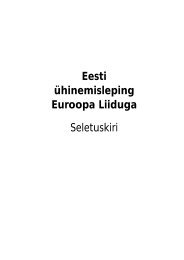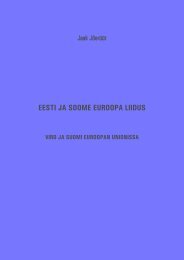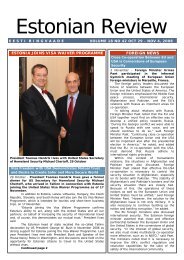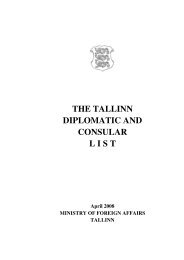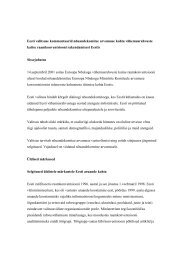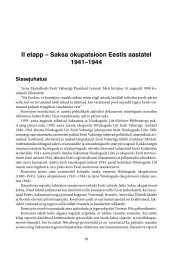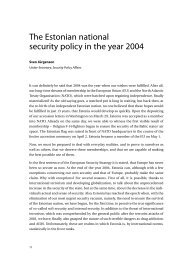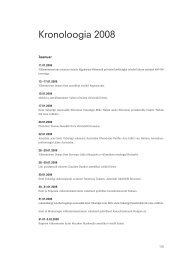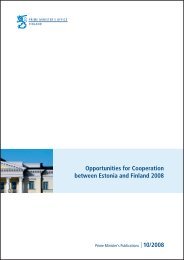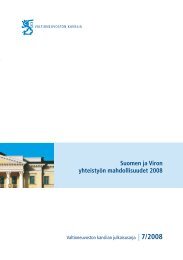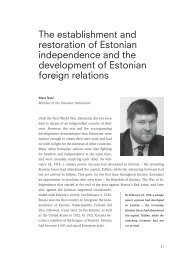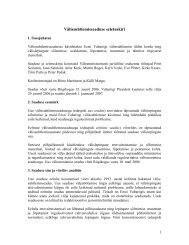You also want an ePaper? Increase the reach of your titles
YUMPU automatically turns print PDFs into web optimized ePapers that Google loves.
-Volume 12, No. 4 April 2008<br />
<strong>Estonian</strong> <strong>Economy</strong><br />
ESTONIAN ECONOMIC POLICY ............................... 1<br />
MAJOR ECONOMIC INDICATORS ............................ 2<br />
FISCAL POLICY................................................................. 2<br />
LABOUR MARKET............................................................. 2<br />
PRICES ............................................................................. 3<br />
STATE BUDGET ................................................................ 3<br />
FOREIGN ECONOMIC RELATIONS ......................... 3<br />
DEVELOPMENT BY SECTORS ................................... 4<br />
BANKING..........................................................................4<br />
ENERGY ...........................................................................4<br />
INDUSTRY ........................................................................5<br />
IT .....................................................................................5<br />
MEDIA. TELECOMMUNICATIONS.......................................6<br />
REAL ESTATE ...................................................................6<br />
TOURISM ..........................................................................6<br />
TRANSPORT......................................................................6<br />
ESTONIAN ECONOMIC POLICY<br />
• According to Finance Minister Ivari Padar, of the total budget revision in the amount of 3.1 billion<br />
kroons (EUR 198), 2.1 billion kroons will be reduced expenses and about one billion kroons extra<br />
revenue. Of the latter, the sale of properties of the state real estate management company RKAS would<br />
contribute more than 300 million kroons. More than 660 million kroons of extra money is forecast to be<br />
received as fines, state dues, dividends and proceeds from the sale of land. The biggest contributors will be<br />
property sale and the dividend of the listed telecommunications company Eesti Telekom. Even though the<br />
scope of the different sections is clear by now, the specific amounts in each case and the objects to be affected<br />
will become clear in the near future. The ministry is on track to submit the draft of the negative supplementary<br />
budget to the government for endorsement by May 15. According to information released earlier, the list of<br />
properties to be sold includes the historic interior building in Pagari Street 1 in Tallinn, a property in Paslepa on<br />
Estonia's northwestern coast formerly used as the president's summer residence, the compound of the former<br />
Pärnu prison, and some other properties. Following the cut by 3.1 billion kroons the state budget for 2008 will<br />
set out 88.2 billion kroons for expenditures, 10.8 billion kroons more than last year.<br />
• The <strong>Estonian</strong> government has launched organization work for Estonia's participation in Expo 2010,<br />
and according to the government's preliminary estimate it will cost nearly 60 million kroons (EUR 3.8<br />
mln). The government decided to appoint Ambassador Toomas Tiivel the highest <strong>Estonian</strong> representative at<br />
the Expo. Tiivel will be coordinating the preparatory work of Estonia's participation in the Expo. Expo 2010<br />
will take place in Shanghai, China, from May 1 to October 31 with the participants focusing on the theme of<br />
cities. In addition to national pavilions there will be different types and forums and events, including national<br />
days, at the Expo.<br />
• Against the backdrop of an overall cooling of the economy, the continued strength of export is having a<br />
positive effect on the <strong>Estonian</strong> economy, analysts say. For the economy it is very good news that export has<br />
remained relatively strong compared with internal demand. This helps the industry to stay buoyant and prevents<br />
the economy from falling into recession. The firming of exports and the decline in imports reported by Statistics<br />
Estonia had been expected. Fewer imported goods are needed as a result of declining consumption and<br />
investments. Since it's more difficult for businesses to sell on the domestic market now, one's busier looking for<br />
opportunities for export. Shipment out of Estonia has remained strong in all traditional branches of export and<br />
also the export of machinery and equipment is starting to recover as had been expected. The growth rates of<br />
export are expected to keep growing in the coming months, as there is no direct reason why the export growth<br />
rates couldn't be bigger.<br />
• The earlier problem of shortage of labor has been replaced by insufficient demand in both industry and<br />
construction in Estonia, it appears from a study by the <strong>Estonian</strong> Institute of Economic Research<br />
(EKI). EKI said that if in the first quarter of last year managers at only 27 percent of the industrial enterprises<br />
covered by the survey named insufficient demand as their main problem then this year it was seen as such by<br />
half the companies surveyed. Labor shortage meanwhile has lost importance as a factor holding back output<br />
ESTONIAN ECONOMY is compiled from materials issued by Bank of Estonia, Statistical Office of Estonia, <strong>Estonian</strong> Ministry of<br />
Finance and from Baltic News Services. Review is issued by the Press and Information Department, Ministry of Foreign Affairs<br />
ISLANDI VÄLJAK 1,TALLINN, 15049 ESTONIA Tel: +372 631 7614 Fax: +372 631 7617 To subscribe please contact:<br />
vmpress@vm.ee, http://www.vm.ee
April 2008<br />
growth and was named as the main constraint by 19 percent of managers in the first quarter of this year,<br />
compared with 36 percent in the first quarter of 2007. In the construction sector the ratio of such companies<br />
dropped from 51 percent to 8 percent. Insufficient demand was named as the most important factor by 58<br />
percent of construction companies in the latest survey, up from 44 percent in December. The good news is that<br />
a third of construction companies are planning to cut prices in the near future. For the government this creates a<br />
good backdrop for making investments and the state should consider going on with planned investments<br />
despite the harder times that have arrived.<br />
• A survey on consumer protection conducted by the <strong>Estonian</strong> Institute of Economic Research shows<br />
that people's awareness of the fact that such a thing as consumer protection law exists has risen to 84<br />
percent, or the same level as in the late 1990s. One-sixth of the population is unaware of the existence of<br />
such a law. At the same time, among Russian-speaking respondents those not aware of the existence of the<br />
Consumer Protection Act made up nearly a quarter of respondents. One-third of the respondents said they had<br />
at least once been disappointed after making a purchase on the basis of an advertisement.<br />
MAJOR ECONOMIC INDICATORS<br />
• Increase in Estonia's exports and imports slowed down in 2007 compared to 2006 and the annual rate<br />
of growth for 2007 was the lowest of the years since the country joined the EU. The export of goods<br />
made up 125.5 billion kroons and import 177.1 billion kroons in 2007. In yearly comparison the value of<br />
exports increased 4 percent and of imports 6 percent, the smallest such figures for the last four years. The<br />
slowdown was partially the result of the rapid growth rate of exports and imports in 2006, when the annual<br />
growth rates were 24 percent and 30 percent, respectively. The trade deficit amounted to 51.6 billion kroons, a<br />
11 percent larger figure than in the year before. In 2006, Estonia's foreign trade deficit expanded by as much as<br />
47 percent. The share of EU countries was 70 percent and that of CIS countries 11 percent in exports. Exports<br />
to EU countries grew 11 percent compared to 2006 while exports to CIS countries were up 14 percent. In<br />
imports the share of EU countries was 78 percent and the share of CIS countries was 13 percent. Imports<br />
from EU countries increased 11 percent but imports from CIS countries dropped 13 percent in comparison<br />
with 2006.<br />
• The number of bankruptcies has considerably increased in Estonia in Q1 compared with the same<br />
period last year. If 72 bankruptcy applications were filed to the Harju County Court in the first 3 months of<br />
2007, then this year there were 119 such applications. In the Tartu and Viru County Courts the number of<br />
bankrutcy proceedings has not increased.<br />
FISCAL POLICY<br />
• The inflow of income tax and VAT revenues into the state budget of Estonia in the first quarter of this<br />
year was smaller than at the same time a year ago. VAT revenues in the first three months of 2008 totaled<br />
4.694 billion kroons (EUR 299.94 mln), making up 92 percent of the sum collected in Q1 of 2007 and 18<br />
percent of this year's target. The intake of personal and corporate income tax, at 698 million kroons, formed 90<br />
percent of the inflow in the first three months of last year and 8 percent of the sum planned for this year. The<br />
personal income tax revenue is at that negative, in other words, tax refunds exceed the sum collected.<br />
Corporate income tax revenue in the three months made up almost 18 percent of the year's target. The social<br />
tax intake added up to 7.513 billion kroons in the first quarter, 20 percent up from the same period last year<br />
and nearly 23 percent of the inflow projected for the current year. Excise taxes totaled 2.281 billion kroons, an<br />
increase of 29 percent year-on-year and 22 percent of the 2008 plan. All told, first-quarter tax intake was 18.394<br />
billion kroons or 11 percent more than at the same time last year.<br />
LABOUR MARKET<br />
• The number of registered unemployed residents in Estonia grew 2.6 percent or by 441 people in<br />
March compared with the preceding month to reach 17,181 at the end of the month. Year-on-year, the<br />
rate of increase was 20.5 percent. Unemployed people registered with the Labor Market Board made up 2.7<br />
percent of the entire capable population from age 16 to pension age. In the course of the month of March<br />
19,427 people searched for a job via the Labor Market Board and 1,480 jobless people became employed. The<br />
number of new job seekers registered as unemployed was 2,957. Unemployed people between ages 16-24<br />
registered with the Labor Market Board numbered 2,126 as of March 31, while people aged over 50 numbered<br />
5,360. Women made up 55.7 percent. The unemployment rate was highest in the southern Valga County, 5.8<br />
percent, and lowest in Tartu County, also in South Estonia, at 1.7 percent. In Harju County, which includes the<br />
capital Tallinn, the rate was 1.9 percent.<br />
• Fears of <strong>Estonian</strong> residents as regards unemployment growth are on the rise and consumer<br />
confidence continues to be low, a recent survey indicates. 7 percent of respondents considered it possible<br />
2
April 2008<br />
that unemployment would grow considerably and 36 considered it possible that it would grow somewhat. This<br />
marks a steep increase compared with the outcome of a similar survey from a year ago. About 10 percent of<br />
households are using savings from earlier periods or live on debt, which is a stable ratio for the recent period.<br />
Eighty-seven percent of households manage to save a little or make ends meet. While half of consumers have<br />
made no changes in their consumption habits as a result of price increases in the past six months, 18 percent of<br />
people are buying the same goods in smaller quantities, 23 percent are buying cheaper goods and 11 percent<br />
are buying cheaper goods in smaller quantities. At the same time, the financial situation of households<br />
remained good in March.<br />
PRICES<br />
• <strong>Estonian</strong> consumer prices rose by 10.9 percent year-on-year in March; in February the annual increase<br />
was 11.3 percent. Goods were last month 10.1 percent more expensive than in the same month a year ago.<br />
Food prices climbed by 14.5 percent and those of manufactured goods, by 6.6 percent. The cost of services<br />
increased by 12.6 percent. Regulated prices of goods and services changed by 19.8 percent and non-regulated<br />
prices by 8.5 percent last month in annual comparison. The inflation was driven mainly by rising food prices<br />
and the increase in the prices of thermal energy, heating materials and motor fuel. Food cost last month 16.7<br />
percent more than in March 2007. Dairy, cereal and meat products accounted for three-fourths of the increase<br />
in food prices. The prices of goods and services were on the average 0.8 percent higher in March than in<br />
February. Month on month, the CPI was most influenced by rises in the prices of motor fuels, bread and fresh<br />
vegetables. Electricity was 2.4 percent cheaper than in February.<br />
• The hike in food prices has not affected the share of expenses on food in households' expenses in<br />
2007, Statistics Estonia has found. Similar to the previous year one fourth of the expenses was spent on<br />
food and non-alcoholic beverages. In 2007 the average expenses per member of household totaled 4,358<br />
kroons (EUR 278), 17 percent more than the year before. Compared with the year before expenses on food<br />
increased by 16 percent, mainly because of higher grocery prices. The share of expenses on food in the<br />
structure of expenses made by household members did not change compared with 2006, however, and also the<br />
amounts of food items bought did not change. Last year a member of the household spent considarbly more<br />
(by one fifth) only on bakery products and vegetables and 14 percent more on dairy products. The share of<br />
expenses on transport and leisure time activities sharply increased in the structure of household members'<br />
spending. The average monthly expenditure increased in all groups of expenses. Expenses on transport<br />
increased the most, by one third. Also expenses on eating out, education, clothes and footwear, leasure-time<br />
activities, food and housing increased on year.<br />
STATE BUDGET<br />
• Estonia continued to have the EU´s lowest government sector debt burden in 2007, or 3.4 % of GDP<br />
compared with 4.2 percent of GDP in the year before, Eurostat said. Also having low ratios of<br />
government debt to GDP were Luxembourg (6.8 %), Latvia (9.7 %) and Romania (13.0 %). Eight member<br />
states had government debt ratios higher than the maximum 60 % of GDP allowed by the Maastricht treaty.<br />
• The <strong>Estonian</strong> government's fiscal policy is slackening, Vice President of the central bank Marten<br />
Ross said. In the central bank's opinion, this year will witness a marked slackening of the budget policy. If last<br />
year the budget surplus reached almost 3 % of GDP then this year the government's aim is a balanced budget.<br />
This course means the government's fiscal policy this year is supportive of economic growth as the share of<br />
public spending in relation to GDP will increase. It would be better if the state's budget policy ran counter to<br />
the economic cycle. The 2008 state budget should have had a 2 % surplus in relation to GDP from the first<br />
and the government should not have planned so large expenditures at all. In the present situation it is even<br />
more important to plan the 2009-2012 budgets with smaller outlays, Ross said.<br />
FOREIGN ECONOMIC RELATIONS<br />
• Estonia and Georgia have started negotiations to launch regular flights between Tallinn and Tbilisi.<br />
Interest toward operating the route was expressed by the Georgian carrier Georgian Airways. The attitude of<br />
Georgia's ministry of economic development and the aviation authorities toward the opening of an air route<br />
between Tallinn and Tbilisi is positive and there's big willingness on both sides to open this air route. Before<br />
the route can be opened an aviation agreement has to be signed between the two countries, which may take 3-4<br />
months. The target group for the new route are tourists, businesspeople from Georgia and the Nordic<br />
countries, and officials. According to preliminary information, Georgian Airways is prepared to fly between<br />
Tallinn and Tbilisi twice weekly. The new route could be opened next year.<br />
• According to PM Ansip, problems may emerge in certain projects with the absorption of EU support<br />
allocated to Estonia in the previous financing period even though ministers are optimistic. Ansip<br />
3
April 2008<br />
named projects such as the 43 million kroon (EUR 2.75 mln) labor market measures plan, the Emajõgi River<br />
catchment basin water management project worth 700 million kroons, the construction of a breakwater in the<br />
port of Tallinn for 371 million kroons, and the Kukruse road construction project budgeted at 590 million<br />
kroons. It is not fully certain at this point that Estonia will manage to implement those projects and use up the<br />
EU money. Absorption of EU support is particularly important in the present economic cooling situation<br />
where utilization of EU monies would support the economy among other things by bringing extra taxes into<br />
the state budget. Estonia has until the end of 2010 to distribute the EU support of the previous financing<br />
period.<br />
_______________________________________________________________<br />
Further information is available:<br />
http://www.eestipank.info/pub/en/dokumendid/statistika/<br />
_______________________________________________________________<br />
DEVELOPMENT BY SECTORS<br />
BANKING<br />
• The <strong>Estonian</strong> competition authority is going to study the size of banks' card payments. The<br />
Competition Board is very much interested in the financial sector. It has planned an analysis of cross-bank card<br />
use for 2008. The issue was taken up by the European Commission. If it has been found in Europe that there<br />
are problems with free competition in that respect, then it is also an <strong>Estonian</strong> problem. However, it is still early<br />
to assess what the investigation could bring. The service charges could be too high, but the results of our<br />
survey will only be established at the end of the year.<br />
ENERGY<br />
• The <strong>Estonian</strong> Foreign Ministry wants to find out why a report on the environmental impact<br />
assessment for the extension of Finland's Olkiluoto nuclear power plant does not cover the issue of<br />
informing the international community about a nuclear incident or catastrophe. The Foreign Ministry<br />
also suggested that Estonia take part in the environmental impact evaluation. Remarks and proposals on the<br />
Olkiluoto environmental impact assessment report can be filed till April 20.<br />
• AS Narva Elektrijaamad (Narva Power Plants) is planning to start burning biofuel in combination<br />
with oil shale at one of its two large power plants. The new generating unit using the circulating fluidized<br />
bed technololgy at the Baltic Power Plant is suitable for burning fuel of low combustion value and that up to<br />
10 percent of biolfuel can be burned alongside oil shale in its furnaces. Given that the electricity output<br />
capacity of the reconstructed generating unit is 215 megawatts, implementation of the plan would provide<br />
Estonia additionally with more than 20 megawatts of capacity based on renewable sources of energy. Besides,<br />
an estimated 150,000 tons less oil shale would be needed annually. Readjusting the existing furnaces that use<br />
the circulating fluidized bed technololgy so that they can burn also biofuel is the cheapest and most effective<br />
way for increasing the amount of renewable energy. It would create a stable and long-term demand on the<br />
market for wood chips and other low-value biomass.<br />
• The Baltic Sea region needs extensive investments to meet the increasing demand for energy and<br />
reduce hazardous emissions in the coming years, Johnny Akerholm, president and CEO of the Nordic<br />
Investment Bank (NIB), says. Akerholm emphasized that the Baltic Sea region faces a challenge in securing<br />
the long-term energy supply. It is important to continue integrating national energy systems while also securing<br />
adequate investments in new generation capacity. Investments are needed in order to increase the share of<br />
non-fossil energy, reduce emissions and introduce new technologies in areas such as energy efficiency, carbon<br />
capture and storage. The energy systems also have to be adapted to the consequences of climate change, such<br />
as more violent storms causing damage to networks and other infrastructure. Action must be taken and soon.<br />
Otherwise, the rising demand will lead to even more sharply increasing energy prices, which will threaten the<br />
growth of the region in the longer term.<br />
• Eesti Energia will invest 5.4 billion kroons (EUR 345 mln) during the financial year starting in April.<br />
2.2 billion kroons of the investments will go into grids according to plans. This is more then ever before.<br />
In power grids, the priority is raising the quality of grid services and remote reading of meters. The company is<br />
planning to invest 2.2 billion kroons into the energy generation sphere. That sum does not include a possible<br />
investment into a new oil-shale fuelled power bloc or other major project, which will be separately discussed by<br />
the Eesti Energia supervisory board. Of the production investments in the plan a considerable share, 1.2 billion<br />
4
April 2008<br />
kroons, will go into renewable energy, with the rest going to ensure reliability of power plants and to increase<br />
their life.<br />
• The generation of wind energy totaled 26.8 gigawatt-hours in January and February this year, 81<br />
percent percent higher than the year before. Hydroelectric power generation increased by nearly 28 percent<br />
to 5.1 gigawatt hours during the two months. In all, a total of 2,121 gigawatt-hours of electricity was generated<br />
in Estonia in January-February, 8 percent more than in the same period the year before. Electricity import fell<br />
by nearly tenfold to 27 gigawatt-hours against the previous year. In the same period export fell by about 17<br />
percent to 286 gigawatt-hours. The fall in thermal energy output was by nearly 12 percent to 2,095 gigawatthours.<br />
• Eesti Energia has signed a contract with the Jordanian government and the state-owned National<br />
Electric Power Company on the construction of the first oil-shale fuelled power plant in Jordan. Eesti<br />
Energia will get the exclusive right to develop a project aimed at the construction of a power plant of up to 900<br />
megawatts. During the next 3 years studies as well as the necessary preparations for making the blueprints of<br />
the construction work will be carried out under Eesti Energia's leadership. Eesti Energia's main role in the<br />
project is sale of knowhow. The capital necessary for the construction of the plant can be borrowed from<br />
major investors. The power plant to be built in Jordan would be the first considerable oil-shale fuelled power<br />
plant operating outside Estonia. Khaldoun Qutishat, the Jordanian minister for energy and mineral resources,<br />
said the <strong>Estonian</strong> Energy project was a breakthrough as launching of electric power generation on the basis of<br />
local fuels would realize the country's decades-long aspiration of reducing its independence from imported<br />
energy carriers.<br />
• <strong>Estonian</strong> PM Ansip met with Lithuanian President Adamkus and confirmed that Estonia was very<br />
much interested in going on with the Ignalina nuclear power plant project. Estonia wants to take part in<br />
the Ignalina project, because it is a sensible decision. The parties stated at the meeting that Estonia and<br />
Lituania had the same aims in the energy sphere. To achieve them the Baltic countries will have to closely<br />
cooperate because the energy issue is important for all the three countries. The parties also stated that it was<br />
important for the Baltic countries to create additional links with other EU countries. Both the countries are<br />
actively working in that direction.<br />
INDUSTRY<br />
• The Australian stock exchange-listed company Monaro Mining NL wants to explore the Ida-<br />
Virumaa region for different metals including uranium and gold. Monaro Mining NL founded a<br />
subsidiary, Balti Kaevandused ja Uuringud (Baltic Mines and Exploration) in Estonia last year. The<br />
Environment Ministry received on March 13 two applications for exploration title in its name which cover an<br />
area of around 20,000 hectares in the Vaivara, Toila and Illuka municipalities. The aim of the exploration is to<br />
assess workable quantities of mineral resources and perspectivity of concentrations. The list of metals to be<br />
searched for includes iron, molybdenum, copper, lead, zinc, uranium, vanadium, gold, silver and platinum. In<br />
the course of the exploration up to one hundred 60-500 meters deep holes are to be drilled. Permission is<br />
sought for a period of five years.<br />
IT<br />
• A GfK Custom Research Baltic poll carried out in February revealed that 69 percent of <strong>Estonian</strong>s aged<br />
15 to 74 have home computers. According to the poll, the number of Internet users is the same. The<br />
overwhelming majority of <strong>Estonian</strong>s aged 15-45 own computers, and also the percentage of Internet users is<br />
the highest in that age group. In the age group 46-74 nearly half have home computers and there are as many<br />
Internet users among middle-aged and elderly people. Self-employers persons, persons holding managerial<br />
posts or working as specialists are morer often owners of home computers than others. Home computers and<br />
use of the Internet is more common also among persons with secondary or higher education. Nationality made<br />
no difference in the ownership of computers or use of the Inernet. Of pensioners one fifth own home<br />
computers, but their percentage of the Internet use is slightly lower.<br />
• The cooling of the economic environment has not had a significant impact on the sale of computers<br />
in Estonia, computer sellers say. The market of home users continued to grow in the first quarter and no<br />
major changes took place in corporate demand either. According to the ML, sales to the public sector happen<br />
at their own pace owing to the one-off nature of public procurement tenders. In regular sales, unit sales of<br />
laptop computers of ML grew 46 percent while unit sales of desktop computers of ML dropped 15 percent.<br />
That the sale of desktops is replaced by the sale of laptops is a fully normal process. The manager of the seller<br />
of Apple computers IM Arvutid said that the slowdown of economic growth had not been felt in sales and no<br />
decline had taken place in comparison with 2007.<br />
5
April 2008<br />
• Estonia has retained its 20th place in the Networked Readiness Index (NRI) published by the World<br />
Economic Forum as part of its Global Information Technology Report 2007-2008. Lithuania has<br />
climbed to place 33 from place 39 in the survey published a year ago while Latvia has slid from place 42 to 44.<br />
Published for the seventh consecutive year with a coverage of 127 economies worldwide, the report offers a<br />
comprehensive and authoritative international assessment of the impact of ICT on the development process<br />
and the competitiveness of nations. Among the 12 new members of the EU, countries such as Estonia (20th),<br />
Slovenia (30th), Lithuania (33rd), the Czech Republic (36th), and Hungary (37th) have made remarkable<br />
progress in networked readiness, as well as general competitiveness, over the last two decades. Among these<br />
countries, Estonia, the tiny homeland of Skype, has benefited from a savvy e-leadership from a government<br />
that has fostered innovation and universal ICT access as a platform for improved competitiveness. Another<br />
Baltic state, Lithuania, realizes one of the biggest improvements, by six positions, in Europe from last year. The<br />
top six countries on the scoreboard for 2007-2008 are Denmark, Sweden, Switzerland, the United States,<br />
Singapore and Finland, in that order.<br />
• <strong>Estonian</strong> companies and individuals have registered more than 6,500 .eu domain names in the first<br />
two years of its existence. The .eu web domain is a relatively new thing, but nevertheless interest in it is great<br />
in Estonia. Both entrepreneurs and private individuals regard the .eu domain as a good alternative for the<br />
generic .com, .net and .org Internet addresses and Estonia's top-ranking domain .ee whose registration<br />
conditions are still conservative. Registration for the European .eu web domain opened on April 7, 2006. Since<br />
then, the domain has picked up nearly three million customers.<br />
MEDIA. TELECOMMUNICATIONS<br />
• The <strong>Estonian</strong> government endorsed amendments to the Broadcasting Act, which among other things<br />
brings the date of switching off analog ground wave television forward to June 2010. The state had<br />
earlier set the final date of transition to digital television to before the beginning of 2012. As a result the<br />
government is planning to bring the switch forward by one and a half a years. There are currently about<br />
160,000 families receiving TV signal by their own arials in the analog system. On transition to digital television<br />
these families must acquire equipment enabling digital reception of TV picture.<br />
REAL ESTATE<br />
• According to the Colliers International real estate survey, despite office premises being added to the<br />
existing ones in Tallinn no glut of the market is to be expected in the city this year. The projects being<br />
built are mainly covered with preliminary contracts and the level of absorption remains high. However, as a<br />
result of toughening competition a rise in the level of vacancies and a slowdown in the growth in rental prices<br />
is to be expected. New developments of office premises will overwhelmingly be completed on the outskirts<br />
and business activity is concentrating in new areas outside the city center. Due to the shortage of new plots in<br />
the city center and continued high demand for A Class office premises owners have started reconstruction of<br />
existing office buildings in the city center. Growth in the offer of new office premises has led to the rise of<br />
vacancies; by the end of 2007 the vacancy rate of B class premises was 5.3 percent while the average vacancy<br />
rate of A class premises continued to be very low -- about 1.9 percent.<br />
TOURISM<br />
• In February 72,000 foreign tourists stayed in <strong>Estonian</strong> accommodation establishments, which is 7,000<br />
more than in the same month last year. Compared to February 2007, the number of tourists from Finland,<br />
Russia, Latvia and Lithuania increased. Typically of winter months, <strong>Estonian</strong> residents made up half of<br />
accommodated tourists. Their number grew by about 4,000 compared to February 2007. In February 678<br />
accommodation establishments with 16,200 rooms and 34,400 beds were available to tourists. The room<br />
occupancy rate was 36 percent. The average cost of a guest night was 457 kroons (EUR 29.2), up by 6 percent<br />
year-on-year. A guest night in Tallinn cost on the average 571 kroons, in Tartu 415 kroons and in Parnu 326<br />
kroons. In large accommodation establishments with more than 100 rooms, the average cost of a guest night<br />
was 516 kroons.<br />
TRANSPORT<br />
• Tallink is looking for possibilities to improve the result of the Finland-Germany route, given the<br />
combined effect of its length and the rise in fuel costs. Increased fuel prices have put pressure to the<br />
group results. Costs for fuel have climbed by approximately 297 million kroons (EUR 19 mln) during the first<br />
half-year, marking a rise of 47 percent. Given its length and speed of the service, almost half of the increase in<br />
fuel costs came from the Finland-Germany route. As a result of higher fuel costs and lower cargo volumes<br />
resulting from tougher competition in cargo transportation, the result of the Finland-Germany operation has<br />
6
April 2008<br />
declined. Tallink is currently looking for a solution to optimize the operations of the Superfast vessels and to<br />
improve their utilization. The target is to improve the return on capital in the Superfast segment and to<br />
maintain the group's overall return ratios. Tallink bought the Superfast ferries serving the Finland-Germany<br />
route two years ago for 310 million euros, borrowing 280 million euros for that purpose.<br />
• The Superstar, a new passenger ship of the <strong>Estonian</strong> Tallink Group will go into operation on the<br />
Tallinn-Helsinki route from the end of April. The Superstar has a speed of 27.5 knots, which makes it<br />
possible to cover the distance between Tallinn and Helsinki in less than two hours. The new ship can take on<br />
up to 2,080 passengers and 1,902 lane meters of vehicles. The ship has a total of 186 cabins and 736 beds.<br />
• According to the forecast, the rail freight volume will drop from 44 million tons in 2006 to 27.6 million<br />
tons in 2017, Estonia's minister of economy Juhan Parts said. The forecast assumes that oil products will<br />
largely be replaced by other groups of commodities. A prerequisite for this is investments in the port and the<br />
railway necessary for increasing container handling. A risk factor that has to be taken into account is that upon<br />
completion of Russia's Baltic merchant ports and terminals Russian goods flows will be partly redirected into<br />
local ports and cargo volumes carried on the infrastructure of Eesti Raudtee may therefore decline. Despite the<br />
ministry's firm interest in increasing rail freight volumes it is at present difficult to assess changes in cargo<br />
carriage in the more distant future or after 2017.<br />
• <strong>Estonian</strong> Air has given up flying between Tallinn and Kuressaare. The company decided to stop flying<br />
between Tallinn and Kuressaare this summer because the Avies airline operating on the same route on a state<br />
subsidy is offering a good price and frequent schedule. Flights between Kuressaare and Stockholm will<br />
continue as before on Thursdays and Sundays, but the aircraft will now be flying on the route Tallinn-<br />
Stockholm-Kuressaare-Stockholm-Tallinn.<br />
• Copterline started selling tickets to regular flights between Tallinn and Helsinki starting from April 9.<br />
There will be 12 return flights on every working day. In the fall another helicopter will be added to the<br />
Copterline fleet upon which flights will take place also on weekends. Copterline is resuming flights with a new<br />
type of helicopter, AW139, which takes on 12 passengers and is much more comfortable and quiet compared<br />
with the earlier machines. In the new machine so much has been invested into lowering the noise factor so the<br />
passengers do not have to use ear plugs to protect their ears and can communicate with each other. The<br />
Copterline ticket in the peak hour costs from 1,250-3,100 kroons, at other times tickets are available starting<br />
from 800 kroons.<br />
7



